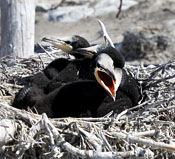Press release 2011-08-09 at 9:00

Cormorant chicks at their nest.
Picture: Pekka Rusanen
A total of approximately 17,700 cormorant nests were found in Finland's sea areas in the summer 2011 cormorant survey – 3,300 nests more than in the previous summer. The number of nests increased in all sea areas except the Bay of Bothnia. In comparison with previous years, however, growth has slowed and only two new nesting colonies were found. Cormorant nests were illegally destroyed in three colonies. In addition, significant nesting losses were discovered in Raasepori, for instance, due to the white-tailed eagle.
Most cormorant nests on the Finnish coast can be found in southern Bothnian Sea (6,297) and in the Gulf of Finland (5,877), while 4,289 nests were counted in the Archipelago Sea, 1,087 in Kvarken and 162 in the Bay of Bothnia. In the Gulf of Finland, the Archipelago Sea and Bothnian Sea the population had increased by 20–24 per cent. Based on only two nesting colonies, Kvarken’s population grew by 51 per cent. In the Bay of Bothnia, however, the cormorant population declined by 20 per cent.
Population growth was focused on the four largest colonies, with a total of 3,050 new nests created in the Gulf of Finland, the Archipelago Sea and the Bothnian Sea. The largest colonies were found in Rauma (2,342 nests), Länsi-Turunmaa (2,000 nests), Kirkkonummi (1,996 nests) and Merikarvia (1,619 nests). Almost half of Finland’s cormorant population nests in these colonies.
Clear growth was observed in one third of cormorant colonies, whereas certain Archipelago Sea and Bothnian Sea colonies showed a sharp decline. Overall, the population increased by 23 per cent.
’However, population growth has significantly slowed down in the 2000s:average annual growth reached 72 per cent in 2001–2005, but only 27 per cent in 2006–2010’, says Research Scientist Pekka Rusanen of the Finnish Environment Institute SYKE.
Only two new colonies were found, one in Hamina and one in Länsi-Turunmaa. As in the previous year, a total of 34 cormorant colonies were detected, nesting on 55 islets. The average size of nesting islets is one hectare, with less than one fifth of cormorants building their nests in the trees on the islets.
In three colonies, a total of 840 cormorant nests were illegally destroyed: 417 in Kustavi, 271 in Luvia and 150 in Länsi-Turunmaa. The destroyed nests in Kustavi and Luvia were located on a nature reserve. Unfortunately, the total number of such nests was somewhat higher than in the previous summer. However, fewer colonies were affected.
In places, the white-tailed eagle caused losses to cormorant nests: for instance, in one colony in Raasepori, almost half of the nests of around five hundred pairs were destroyed due to the impact of the white-tailed eagle. It may prove difficult for cormorants to establish new, successful colonies in areas, such as Åland, with a dense white-tailed eagle population.
The guillemot, a highly endangered species in Finland, nested for the second consecutive year, growing in numbers within a cormorant colony created in 2008 on the eastern Gulf of Finland. The guillemot is found to benefit from the protection cormorants offer from minks in particular. Under such protection, guillemot populations have already grown intensely in Finland.
Further information
Researcher Pekka Rusanen, Finnish Environment Institute SYKE,
tel. +358 400 148 691, firstname.surname@ymparisto.fi
Senior Researcher Markku Mikkola-Roos, Finnish Environment Institute SYKE, tel. +358 400 148 685, firstname.surname@ymparisto.fi
Information Officer Riku Lumiaro, Finnish Environment Institute SYKE,
tel. +358 40 5098 654, firstname.surname@ymparisto.fi